Contact center technology: Trends + features that make life easier for agents (and supervisors)

Customer Support Manager - Tier 1

Tags
Share
Great customer service is a key differentiator for almost any business. But to provide that level of customer service, you need the right tools. Specifically, you need a good contact center platform.
Today, contact center software can do much, much more than it used to. (They definitely don’t just let your agents have phone calls with customers anymore.) But what should you know about the latest contact center technology?
From call center AI that anticipates customer intent and automatically pops up answers to tough questions for agents, to the nuances of contact center integration, there’s a lot that a contact center platform can do to help your team. Having worked in support for almost 10 years, I’ve seen these benefits firsthand.
In this guide, I’ll walk you through some of the most interesting and important trends when it comes to contact center technology, for both agents and supervisors.
Webinar: Discover how Ai can transform your contact center
Learn how Ai can reduce wait times, boost efficiency, support agents and deliver an exceptional customer experience.
What is “contact center technology”?
So, what are contact center technologies, exactly? Well, the term can describe any software specifically designed to help contact center managers and agents do their jobs more easily and efficiently. These include automated systems, customer relationship management, and analytics tools measuring customer behavior and performance metrics.
Contact center technology can also encompass communication- or call-specific tools such as automatic call distribution (ACD), interactive voice response (IVR), and call recording. Whether you run an inbound, outbound, or blended contact center, these technologies can help you improve communication, collaboration, and productivity—as well as reducing operating costs.
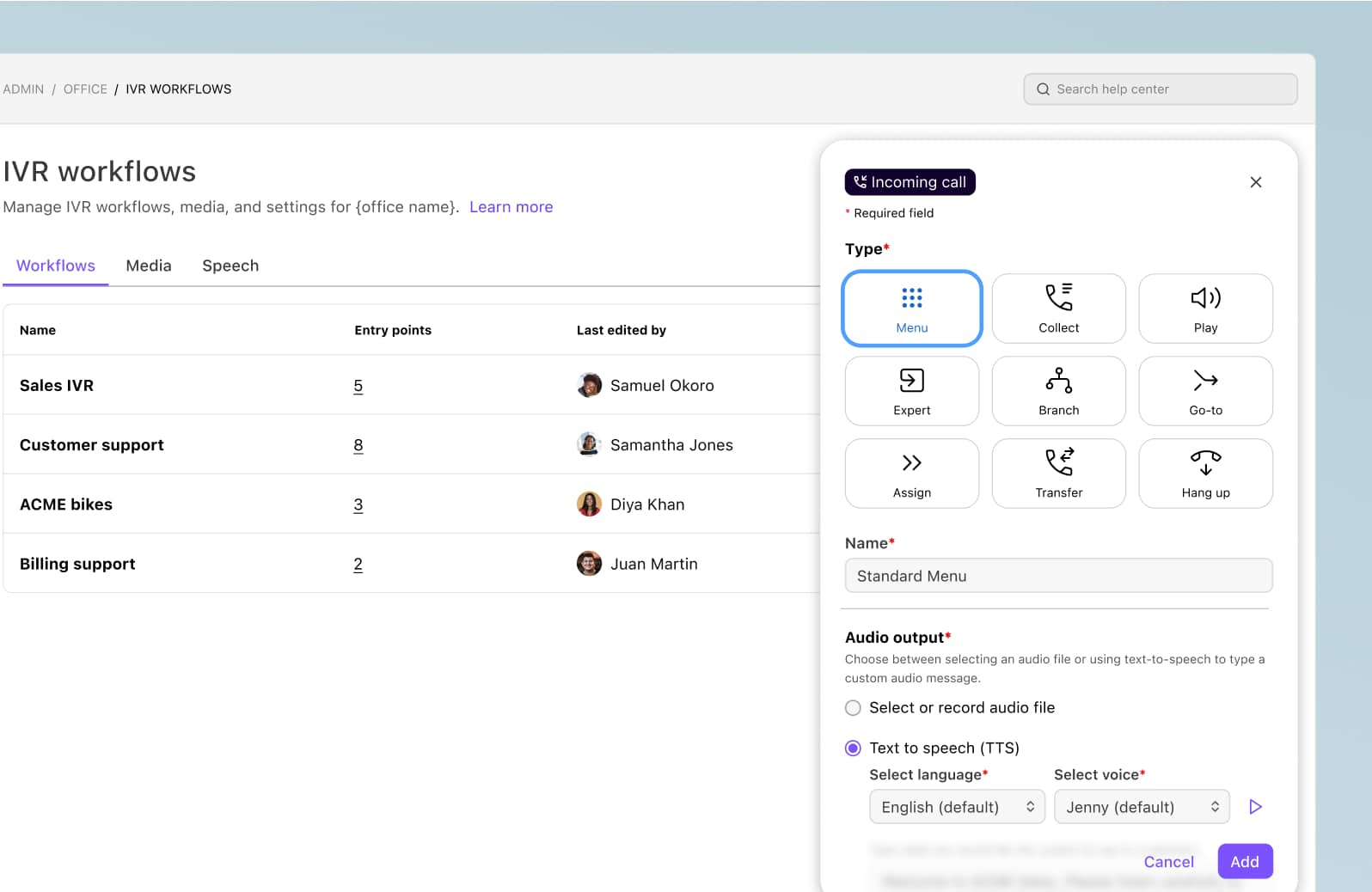
👉 Dialpad tip:
Keeping customers happy is the #1 priority for many contact centers, but it’s important to keep your agents happy, too—and giving them the best contact center technology is a good way to make their jobs easier and ultimately reduce agent churn.
Depending on the size and type of your operation (and of course your budget), you may not actually need every feature that’s available. (More on this in just a bit.) In general though, it’s better to have a solid, versatile solution.
For example, instead of buying one contact center software, and a separate call transcription tool, and a separate video conferencing app, you could choose something like Dialpad's cloud contact center platform, which gives you all three (and a lot more).
Changes in contact center systems technology over the years
Contact center technology has really changed dramatically in recent years, and there are constantly new and exciting developments. (There was a time when we got super excited about things like call routing and auto attendants, whereas now they’re pretty much standard with any decent comms system—or they should be!)
Here’s a quick snapshot at how far cloud contact center technology has come:
Let’s rewind to 1957, which saw the earliest commercial use of a call center. That was when Time Inc. set one up in New Jersey to boost sales of LIFE magazine.
Shortly afterward, when the Private Branch Exchange (PBX) was developed, offices were able to channel all their calls through a few business phone numbers—ditching costly phone lines for each employee.
Further developments that helped call centers grow in popularity include the invention of ACD in 1960, and the 1980s introduction of 0800 toll-free numbers.
In the internet age, businesses began to look beyond local phone companies for more advanced calling capabilities and lower costs—which is when Voice over Internet Protocol (VoIP) technology made its entrance.
👉 Dialpad tip:
The invention of VoIP phone systems was a game-changer because it effectively made call center technology accessible to all businesses over the internet—no clunky hardware needed. Today, call centers have evolved into “contact centers,” managing more communication channels like video, SMS group messaging, and even social media alongside phone calls.
From that point on, things have changed even more rapidly, with the advent of cloud technology and the software-as-a-service model. For example, Dialpad Support has monthly and annual plans, and can be deployed from anywhere on any device, all around the world.
Meanwhile, AI in contact center technology—including machine learning and natural language processing (NLP)—makes it easier to analyze customer behavior and be proactive in giving them the answers they need:
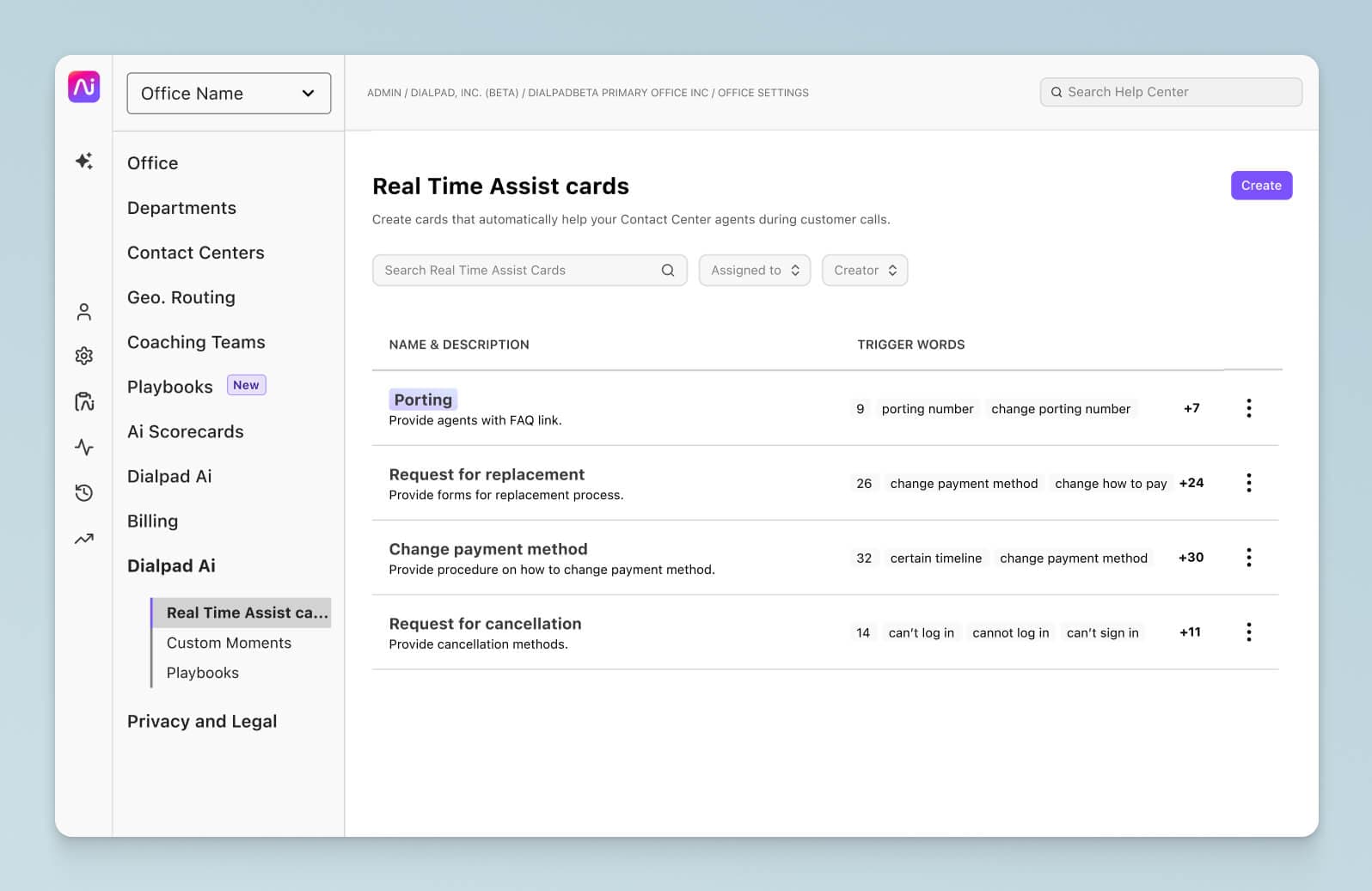
What kinds of technologies are used in contact centers?
As I touched on earlier, the technology used in contact centers is designed to help managers and agents streamline their workflows, be more productive, and give customers and prospects a better experience. Let’s take a look at a few of these in more detail.
1. Telephony
It’s a must-have, and you can’t operate without it. But I included this because there are nuances to be aware of, even when it comes to a seemingly basic feature like telephony. Specifically, things like the quality of your calls and intangibles like ease of use and customer support.
For example, with Dialpad, agents and supervisors can have HD-quality VoIP calls over the internet using a desk phone, mobile device, or even their computer using the softphone app. It’s also infinitely scalable—you can add hundreds, even thousands, of users quickly, without physically installing equipment or wires.
(Very traditional call centers that focus on telephony rather than omnichannel communications may still use landlines and on-premises PBX, but these are now almost extinct. Most have migrated to cloud solutions or hosted PBX by now because a cloud-based system is just much more flexible—and cost-effective.)
✒️ Vetting contact center solutions?
This RFP (Request for Proposal) checklist covers the essentials to be aware of as you're shopping for a contact center platform.
2. CRM integrations
Your business probably stores customer data in a CRM (customer relationship management) platform. That’s great, but you don’t want agents to have to toggle between your phone system and CRM to find relevant information during calls. Because of this, it’s better for agents if you can integrate your CRM with your communications platform—like you can with Dialpad.
For example, Dialpad integrates with Salesforce, HubSpot, and more, giving agents instant access to customer details, combined with features like call transfer and click-to-call. That means that even if an agent has never talked to this customer before, they can still quickly see all those past customer interactions and have full context while helping them. No need to frantically click around or search databases, no need to message all their teammates to see who’s helped this customer before.
👉 Dialpad tip:
Learn more about CTI (computer telephony integration) dialers, which are an important call center technology that lets agents make phone calls from directly within their CRM and other tools—without having to toggle back and forth between windows or tabs. look out for advanced features like customizable caller ID, predictive dialers, and pre-recorded voicemails for sales teams.
3. IVR / ACD
An IVR lets you create a menu of options for callers, with a series of automated prompts. The technology recognizes the responses (based on speech or a touch-tone keypad) and provides simple answers, or directs callers to your knowledge base. It can also invite them to leave a voicemail or request a call-back.
In many cases, IVR helps callers solve their own problems, but it’s smart enough to direct them to a human agent if necessary. Surprisingly, many companies still don’t offer some form of self-service, but it’s an important call center technology because it’s an easy way to automate a potential bottleneck in your customer experience and frees up your agents to handle more complex questions.
ACD and call routing options can automatically distribute calls to available agents based on rules you put in place (such as fixed order, round-robin, or skills-based routing). This improves average time to answer, while directing calls to the most suitable agent saves customers having to repeat information.
4. Call analytics
Contact center analytics are essential for understanding the customer journey and evaluating performance. Most solutions have an analytics dashboard, showing key metrics in real time like staffing levels and call patterns. With Dialpad, this is all built right in. You can view historic data, generate reports, and make smarter decisions without having to contact a support or IT team.
Dialpad also has useful heat maps showing things like call volume and average speed to answer:
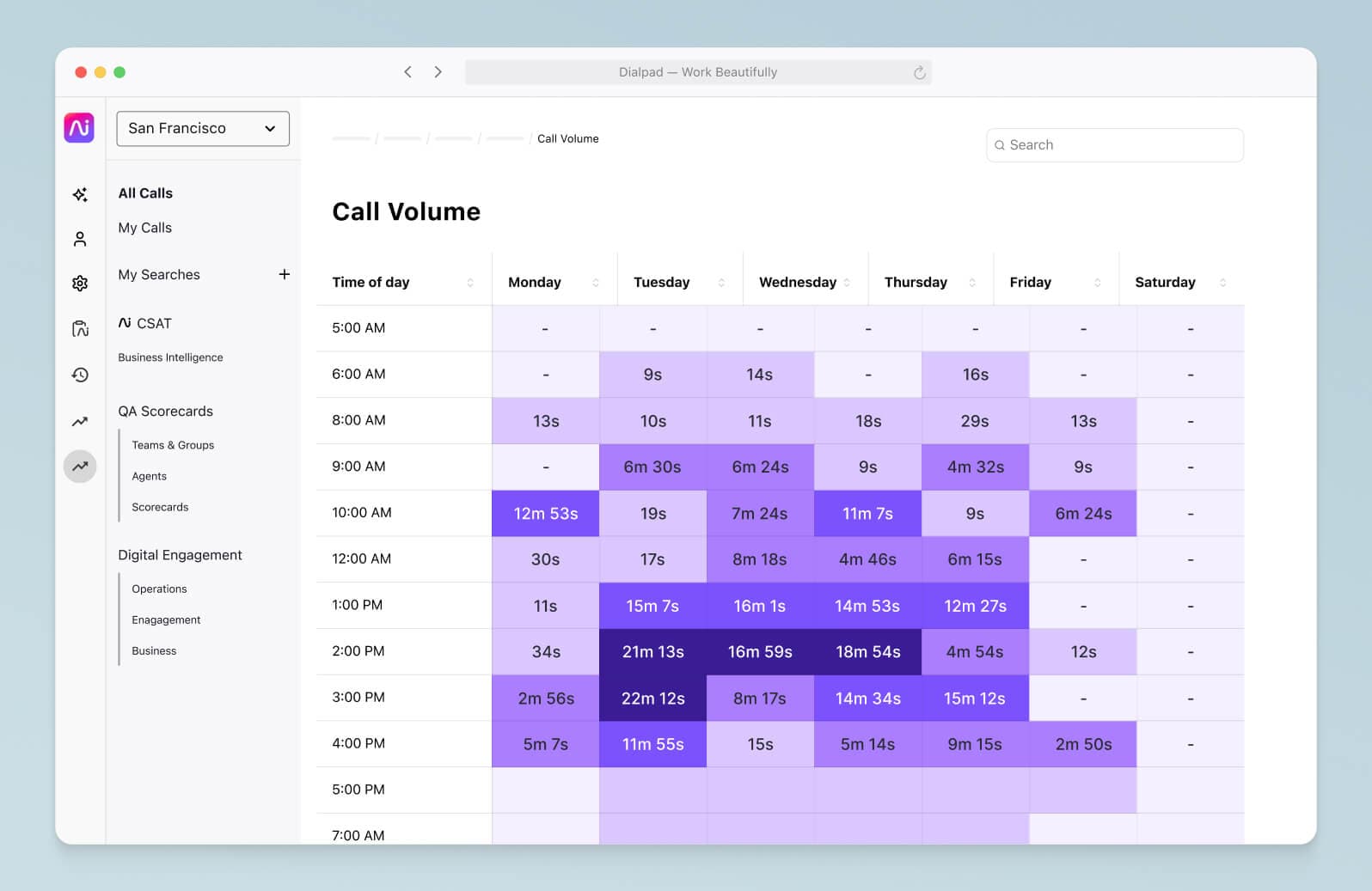
Plus, it also does live sentiment analysis, so managers can quickly scan ongoing calls and step in to help if negative sentiment is expressed.
Last but not least, if you collect customer feedback using CSAT surveys, you probably know that one of the biggest issues with CSAT surveys is the fact that many people don’t bother filling them out. That means you get left with only feedback from the most angry and most happy customers.
To give you a more holistic—and accurate—view of customer satisfaction, Dialpad Ai can analyze your customer conversations and generate a predictive CSAT score, so that you have a much larger sample size:

5. Call recording
Call recording is an essential for contact centers because it helps you avoid and resolve disputes with customers, gives you training material for new agents, and can uncover valuable customer insights. (It also eliminates the need for note-taking, since agents and supervisors have the audio file to listen to afterwards.)
It isn’t exactly a modern call center technology, but there are some new developments that set different tools’ recording features apart.
For example, Dialpad has unlimited call recording (which is almost unheard of, and is in large part thanks to Dialpad’s modern cloud architecture—don’t want to get too in the weeds here, but feel free to ask us about it)
You can even create a call recording playlist of good and bad interactions for agents to access when they need some help or inspiration:
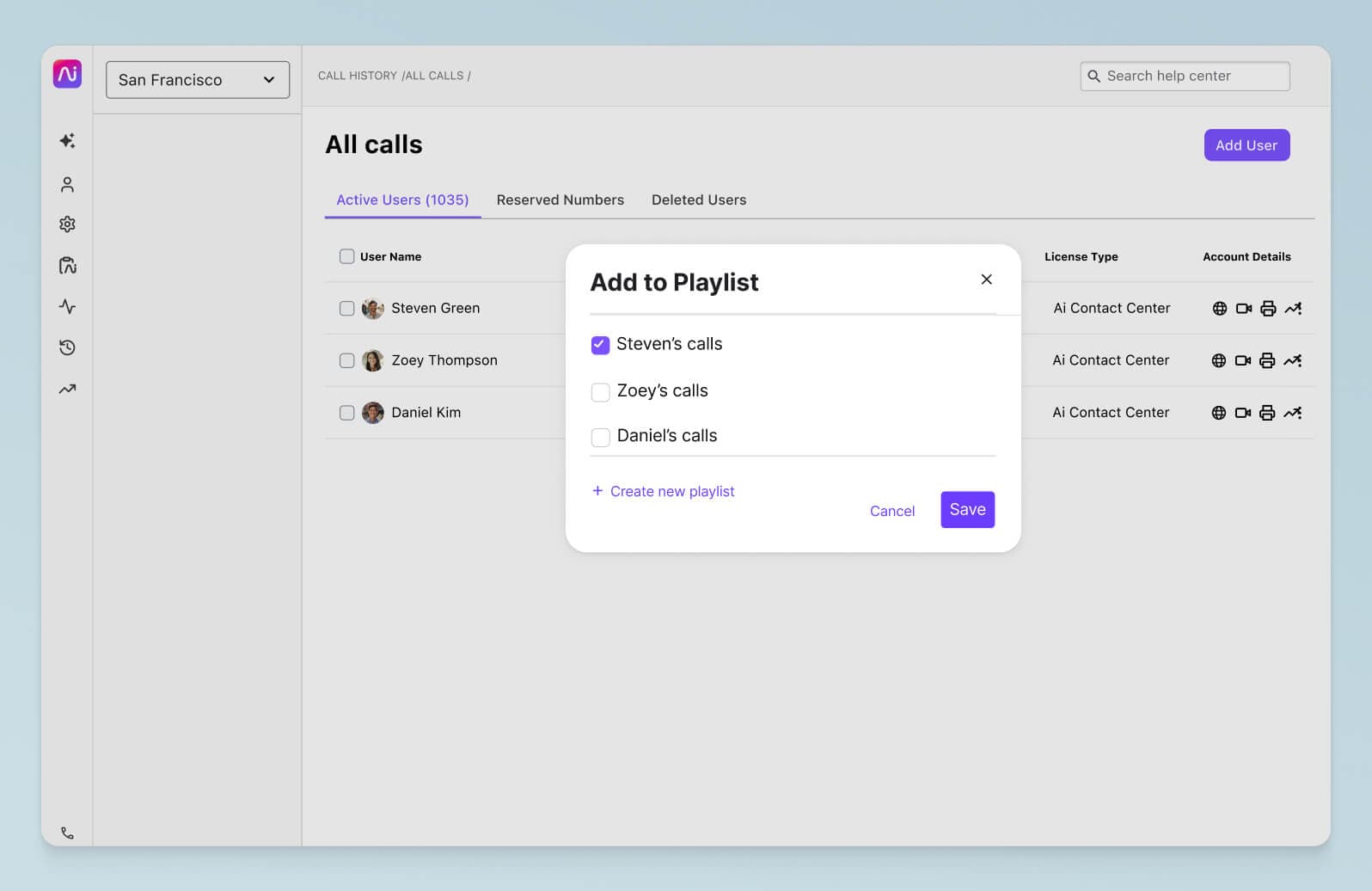
Just remember that there are compliance laws around call recording, and these vary from state to state. Dialpad has a few security-focused features that are designed specifically with this in mind, such as automated notifications and enabling agents to pause recording when sensitive information is being discussed.
👉 Dialpad tip:
As I mentioned earlier, Dialpad also does real-time transcription, which means that you’d have not only the audio recording, but also the transcript and post-call summary handy.
6. Call queuing
Another essential technology in contact centers is a call queuing feature, which helps you organize incoming calls to reduce wait time and improve resolution. It’s especially important if you have just one main phone number for customers to call.
An auto attendant will place calls in a queue according to your pre-set criteria and play an automated message with an estimated wait time and alternative options. For example, Dialpad offers in-queue callback, where a customer can leave a message and receive a call as soon as an agent is free—while keeping their place in line:

Dialpad's customer engagement platform makes it easy to handle call queue management, like prioritizing certain calls, setting minimum and maximum queue lengths, and uploading custom or pre-recorded greetings. (And hold music!) Managers can even receive notifications on queue length and agent availability.
7. Workforce management / quality management
Some contact center technology solutions incorporate workforce management (WFM) and quality management (QM) functionality as well, which gives you even more control over team staffing and agent gamification.
This includes forecasting contact volumes and scheduling employees accordingly, managing day-to-day operations, and ensuring agents have all the resources they need.
With Dialpad, you can easily add new agents to departments, manage phone numbers, and also remove users right from your online dashboard. It also integrates with Playvox to give you more features like automated scheduling, demand forecasting, and deep analytics.
Quality management (QM) is more about getting the best possible performance from your agents, while recognizing that they’re human beings—they’re not robots, and you wouldn’t want them to be. (That’s what AI is for!)
QM features help managers spot areas for improvement. Dialpad’s Playvox QM integration helps managers identify and prioritize areas for skill development, reward agents with points that they can exchange for gifts, and translate customer sentiment into actionable metrics.
4 contact center technology trends to follow
To be fair, these trends are already here. It may still be early days and consumers and business are both still getting used to these contact center technologies, but at Dialpad we truly believe this is where the future is heading.
(Get a closer look at the call center trends to be aware of.)
1. Chatbots
Chatbots have been a bit of a divisive issue. They’re growing in popularity as more and more consumers demand self-service options, but many people believe they have some serious limitations.
One dislike that people have about chatbots is that they’re just not very smart. Yes, they handle simple questions, but anything more complicated than a “yes/no” question would require you to have a phone call with someone anyway.
What’s important to note here is there are different types of chatbots. Some are pre-programmed with basic responses to FAQs, and can only respond when triggered by the right keyword or when the customer clicks an option. The more advanced kind use NLP to converse on a more human level, and can actually learn more words (and understand context) as they carry out more interactions.
What’s unique about Dialpad's customer engagement platform is that its self-service or chatbot can search not only FAQ pages for answers to customer questions, but also unstructured data like PDF documents and even past customer calls. This means it can find more answers, to more difficult questions:

Dialpad is fine-tuning its Ai and natural language understanding, but keep in mind that chatbots aren’t meant to replace humans. To provide the best customer experience, you should always have an easy way for customers to escalate a chatbot conversation to a voice call or video call with an agent—which you can do with Dialpad!
TL; DR - Self-service should complement your other live communications options.
2. Omnichannel support
Customers are all about convenience, and an inbound contact center should be able to manage questions on a range of channels including phone, video, SMS, chat, social media.
👉 Quick side-note:
This is in contrast to multichannel support, where every channel’s conversations and data exist in silos and it’s harder to provide a holistic customer experience. When in doubt, go with omnichannel support.
What’s unique about Dialpad’s omnichannel contact center product is it unifies digital and non-digital channels to create more connected customer journeys and seamless interactions between channels. Plus, agents can access everything in one platform without hopping between a ton of different apps.
If you’re finding that agents are getting overwhelmed by the volume of calls and other interactions, you might want to consider whether to have designated agents for each channel, or to equip them to deal with inquiries across several channels.
(You can create an even better omnichannel experience if you integrate your system with other business software you’re using such as CRMs, ticketing tools, and workflow automation tools.)
3. Cloud migration
Whether it’s because of mobility or flexibility (or both), more and more businesses are moving toward cloud contact center technology.
There’s also the fact that on-premises contact centers tend to be expensive and not very scalable. You have to look after all the equipment yourself, call in an IT team to troubleshoot small problems or install updates, and, if you want to add more users, you’ll have to physically wire in new desk phones and potentially servers. All that equipment takes up space, which means you need a large office space (along with all the associated costs).
Cloud-based contact centers are a lot more affordable. You don’t need your own servers, as the whole system is housed in the cloud. It’s also owned by your service provider—like Dialpad—who takes care of maintenance and upgrades (plus security updates and regulatory compliance). You just pay a monthly or annual fee, and you’re good to go if you have an internet connection.
With cloud solutions like Dialpad, it’s also fast and easy to spin up a new contact center or add more users, and you can operate fully remote or hybrid hot-desking teams to save on office rental fees. What is unique about Dialpad is how scalable it is. Not all cloud solutions make it easy to add thousands of agents to the platform, but Dialpad is one of the very few that can.
4. Artificial intelligence
Finally, we can’t forget about artificial intelligence—it’s the term on everyone’s lips when it comes to contact center technology. The thing is, AI is already powering all sorts of useful features.
For example, Dialpad Ai does a range of different things for contact center teams. It:
Transcribes calls in real time
Logs action items automatically as they’re spoken
Pops up Real-Time Assist (RTA) cards to help agents with tricky questions
Tracks keywords or phrases of interest via Custom Moments
Powers Dialpad’s self-service chatbot feature
Generates and emails a post-call summary to attendees on a call
And more…
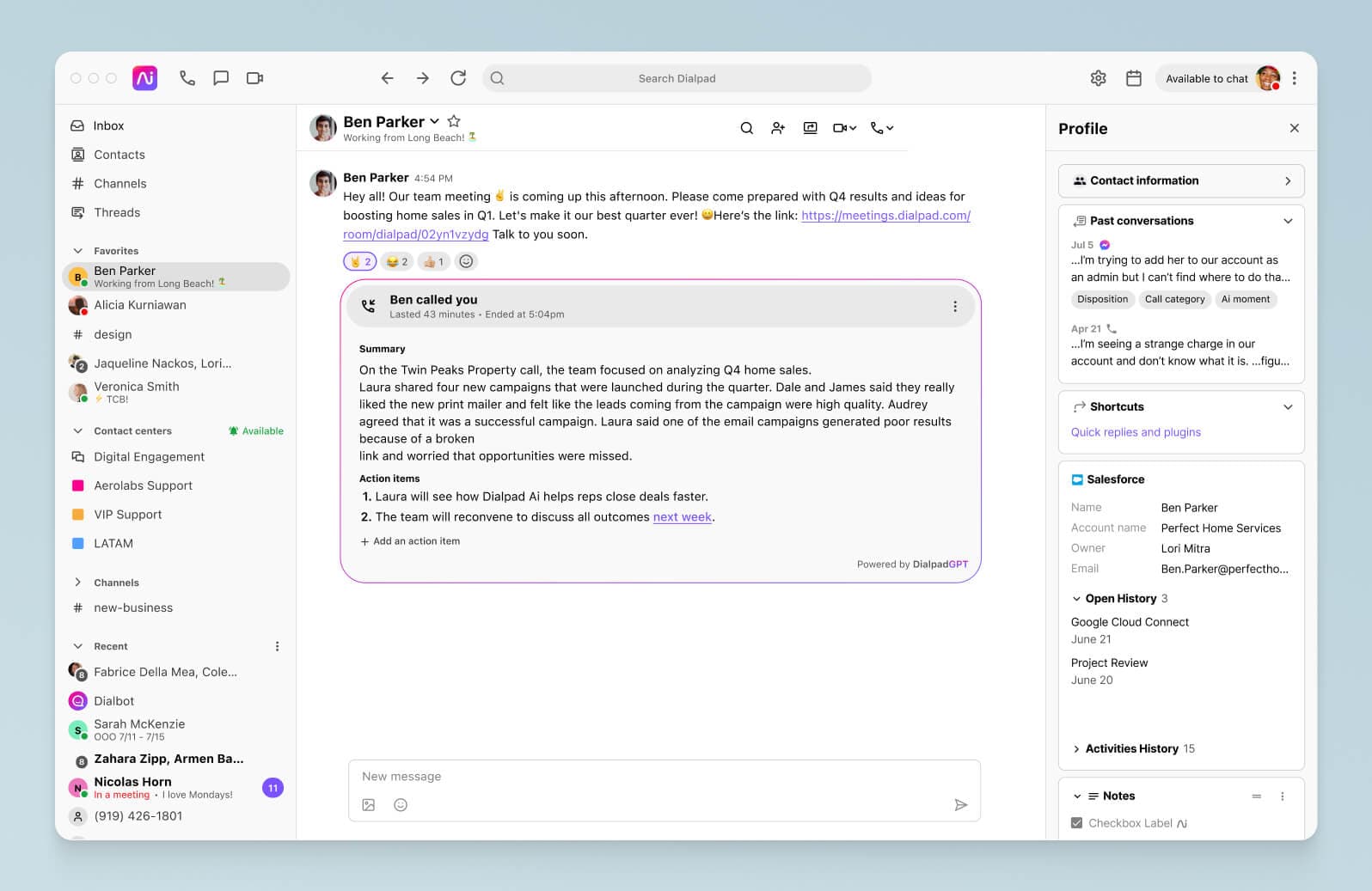
Provide a better customer experience with the right contact center technology solution for your business
Now that you know all about the contact center technology basics, you’re ready to make some decisions about the future of your contact center—and if you’ve decided to upgrade to a new system, why not check out Dialpad?
Alongside advanced features built right into a user-friendly unified communications platform, Dialpad provides enterprise-grade security, 100% uptime for Enterprise customers, and 24/7 customer support across phone, live chat, and web. Book a product tour now!
Looking for contact center technology that empowers your agents?
See how Dialpad can help your business deploy hundreds, even thousands of new agents, around the world—and let your team work from anywhere, on any device. Or, take a self-guided interactive tour of the app!








